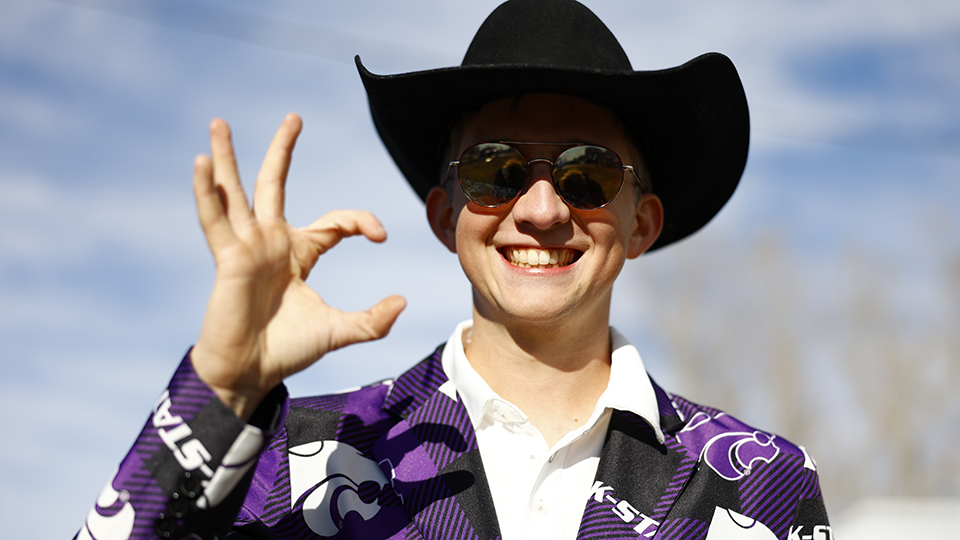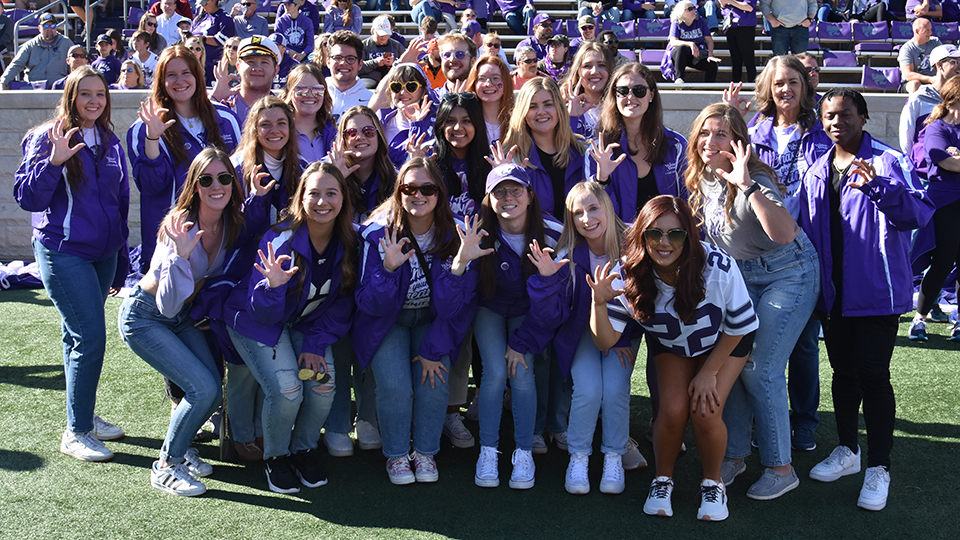From the archives: A history of the now-famous Wildcat hand sign
If you hop on social media on a K-State game day, you’ll find plenty of group photos
of fans dressed in purple, either at a tailgate or in the stands, posing as they prepare
to cheer on the ’Cats to victory. And in many of those photos, you’ll likely spot
those fans displaying the famous Wildcat hand sign.
The claw-like gesture forms the “W” and “c” of the word “Wildcat” and has become a
favorite way for fans to display their K-State pride.
As we all get hyped for the upcoming football season, we decided to dig back into
our archives and share the story of how this now-beloved hand sign got its start.
[Fun fact: This article, which originally appeared in the fall 2012 issue of our member-exclusive
K-Stater magazine, was written by then recent grad Tim Schrag ’12, who is now the
editor of the K-Stater.]
It’s Saturday in Bill Snyder Family Stadium. In attendance are 50,000 purple-clad
K-Staters cheering for a Wildcat victory. K-State leads by a field goal. It’s second
down from the Wildcat 30. The opposing team has the ball. The opponent needs 6 yards
for a first down. A roar has consumed the sports complex and can be heard as far as
Westloop Plaza. Down in the student section, the drum line lays down a beat simply
called Zeppelin. Students in the front rows — the ICat and GA areas — pound on the railings while
the rest of those in the student section raise their right arms in the air and quickly
drop them to the clang of the cymbals. They mimic a vocal riff from Led Zeppelin’s
Immigrant Song. The opposing team snaps the ball. K-State sacks the quarterback for a loss of 5
yards. It’s now third down and the drum line is playing faster. The crowd has gotten
louder. Fans all across the stadium have raised their arms to the beat and also have
begun to mimic the riff. A rookie band member looks out at the crowd and notices something:
The fans have arranged their hands to look somewhat like a claw. She asks a veteran
member of the Pride what they are doing, and he responds, “They are making the Wildcat
hand sign.”
For Kristen Eck Hodgkinson ’13, this was a real scenario. [Editor’s note: At the time of the article’s publication, Hodgkinson was a senior
in elementary education.]
“Everything is so new and you’re just running around like crazy and you hope that
you get into your spot. The drums start playing Zeppelin and then you see everybody’s hands go up. You turn to your section leaders or the
vets standing next to you, and they show you how to make the Wildcat and you pump
it and it’s awesome,” she said.
Hodgkinson, who also served as an assistant drum major for the K-State Marching Band,
said the hand sign was her default pose when cameras came her way.
Hand signs in football date back to the 1950s with origins in Texas. The most well-known
being Hook ’em Horns for the University of Texas, but travel across Texas, and you
will find others such as Gig ’em in College Station, the Horned Frog in Fort Worth,
Sic ’em Bears in Waco and Guns Up in Lubbock.
K-State’s Wildcat hand sign has been around since the mid-2000s and caught on quickly.
Frank Tracz, director of bands and professor of music, said the idea of the Wildcat
hand sign came about spontaneously as the result of the band playing Zeppelin.
“I heard that drum beat and the singing and I thought, ‘Man, this would be a great
cheer,’ so we brought it back, wrote it out and had the drums do it and the band sing
it,” Tracz said. “Then all of a sudden they started with their fists and then pretty
soon I turn around and they’re doing something with the ‘W’ and the ‘c’ and I couldn’t
quite make it out. To tell the truth I had to ask the band what they were doing …
and then I look around and the student section is doing it.”
Much like the hand sign, the dance associated with the Wabash Cannonball sprung up somewhere from the band and has taken on a life of its own.
“This Wabash thing started when there was nobody in the stands, so there was nobody
to do that dance. And now all you need is those first couple measures of the drums
and everybody knows,” Tracz said.
Tracz also said the band is always looking for new things to implement into its arsenal
of songs to rev up the crowd. The ones that get the fans involved tend to stay in
the lineup.
“That’s (the band’s) role,” he said. “I think we have to keep things going, and the
difficult thing for us is that we’re affected by the same psychological ups and downs
that every normal fan is and it’s difficult to cheer and play the fight song when
things aren’t going your way and it just affects everybody. You just have to keep
it positive and keep it going. And no matter how far we’re down, we’re going to come
back and win this thing.”
Today the Wildcat hand sign has gone from something used at football games to a constant
in K-State pictures.
“It’s a way you cheer and exhibit pride in your university and something special and
unique to us,” Hodgkinson said.
>>>Don’t forget to tag us in your game day photos this fall!
Facebook
Twitter
Instagram


